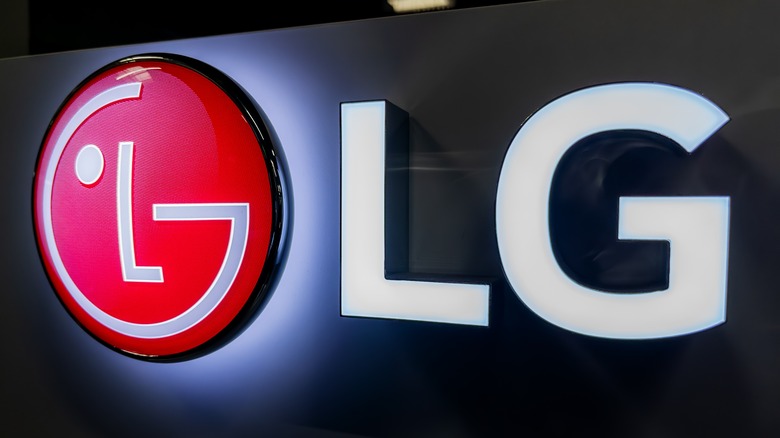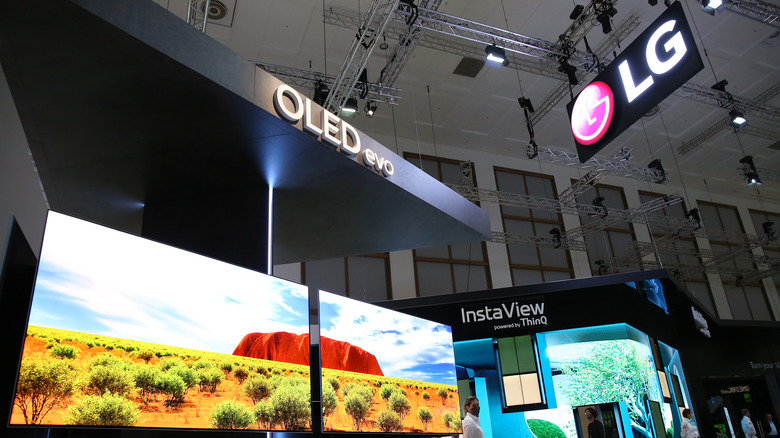What Does LG Stand For? A Look At The Brand's History
As one of the biggest brands in consumer technology, most people know LG for its displays. From massive TVs to gaming monitors and beyond, LG displays are among the most sought after on the market. LG is also known for high-end household appliances like refrigerators, vacuums, and washing machines, as well as laptops, projectors, soundbars, and much more. How did the company grow to its current size and influence? What does it have to do with those two letters, LG?
Off the bat, the acronym "LG" stands for many things, but most of all, it stands for "Lucky Goldstar" — the name the company has officially operated under since 1983. It has always operated businesses under the Lucky name — and later the Goldstar name — in its home of South Korea since its establishment in the late 1940s. Since then, the company has often recycled its distinctive two-letter moniker for marketing purposes, most notably its slogan: "Life's Good." According to LG, this reflects the happiness it wants customers using its products to feel — its founder, Inhwoi Koo, named the company Lucky because it sounded like the Korean "Lak Hui," which means to give joy to everyone.
However, joy alone does not build a tech giant. As LG is one of South Korea's largest dynastic businesses that helped the country build its way to economic success in the latter half of the 20th century. Here's how a simple cosmetics company became a global player on the technology market.
From Lucky Goldstar to Life's Good, LG means many things
To understand LG, you first need to understand Korean chaebols. A chaebol is a family owned business, but not like the ones in the U.S. These multi-industry empires have defined South Korea's meteoric economic rise during the 20th century, forming the backbone of a powerhouse economic force in the region. The closest comparison in the United States might be Walmart, which is owned by the Walton family. The largest of these chaebols is Samsung, which is why Samsung makes so many weird products. LG is structured similarly.
In the United States, LG is primarily known for its TVs and other consumer electronics — but the LG Corporation, which is headquartered in the Yeouido-dong, Yeongdeungpo District of Seoul, is the fourth largest chaebol in South Korea. It has operations in chemical manufacturing, telecommunications, and more. In fact, the first product LG ever made in 1947 was a cosmetic called Lucky Cream, which was manufactured by LuckyChemical Co., Ltd. Much later on, that name was streamlined to LG Chem, which still operates today.
By 1952, LG had expanded into chemical manufacturing by acquiring an industrial company and opening a factory. After pioneering injection mold manufacturing processes in Korea, it was in 1959 that the company finally entered the electronics business, producing the first radio in Korea. Radios would continue to be a staple in the '60s, along with fans and telephones. During this decade, the company began shipping to the United States.
LG's expansion and the 21st century
Post-World War II, the South Korean economy lagged behind that of its northern counterpart, to say nothing of the Western economies. Today, it is an economic powerhouse in the region and a part of the global North. This economic miracle, as it is often called, came thanks in large part to the phenomenon of Korean chaebols. The families who owned these conglomerates became immensely rich and powerful, maintaining their status by cozying up to political leadership. As the fourth largest chaebol, LG's Koo family got to its position of power through a combination of technological innovation and political savvy.
After its initial success, LG was one of a handful of chaebols to help drive the Korean economy skyward during the latter half of the 20th century. By 1976, it had produced more than one million TVs, and by the early '80s it was expanding into products like VCRs, computers, and cameras. It is around this time that the company officially became Lucky Goldstar, with the change becoming official in 1983. Around that time, the Koo-owned company was beginning to specialize in producing processors and microelectronics. Along with its already popular TV business, it's easy to connect the dots from then to now.
In 1995, Lucky Goldstar officially rebranded to LG. That same year, it also acquired a home appliance company in the United States. The rest is history (just like LG's failed smartphone division), and under current chairman Kwang Mo Koo, LG has continued to expand into areas like AI and foldables. From a humble cosmetics company to a multinational conglomerate, the journey of LG is the story of South Korea's economic triumph. There's a 77-year history behind that 77-inch LG TV in your living room.


